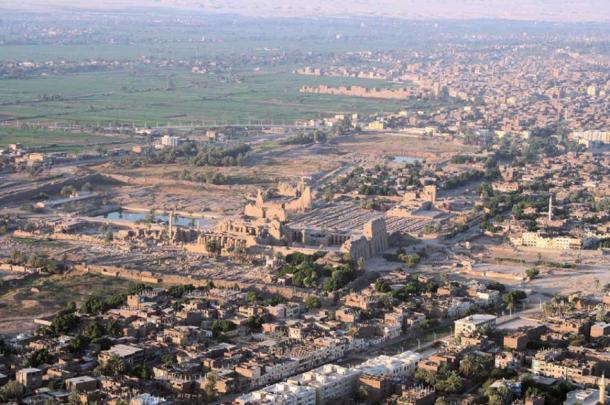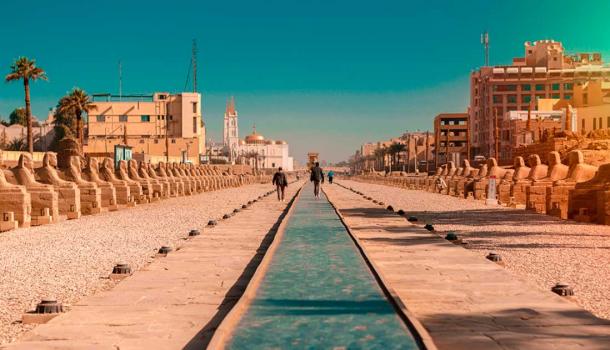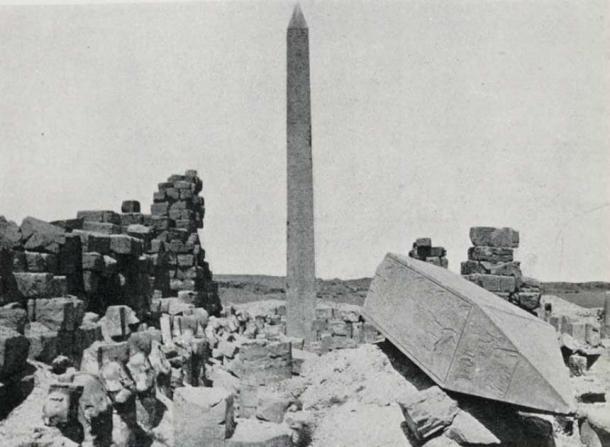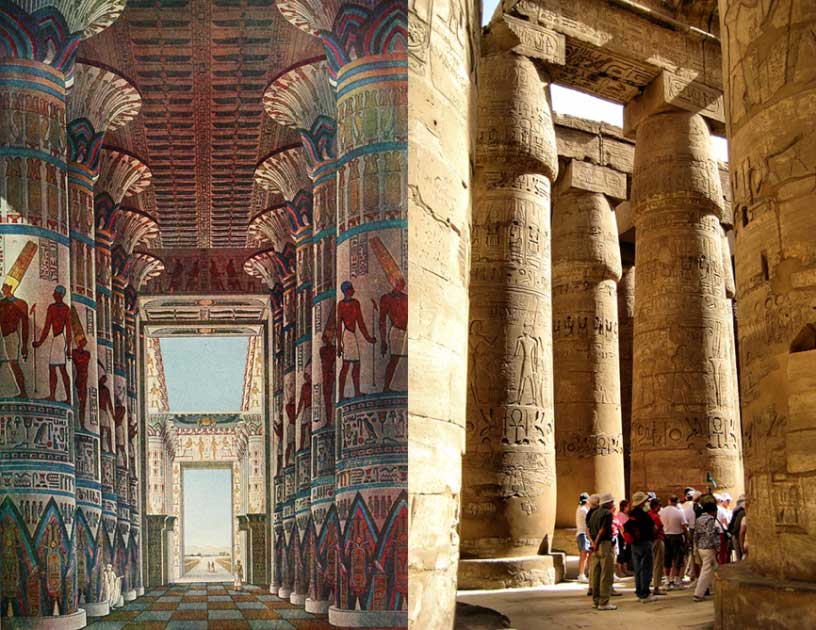
The Awe-Inspiring Karnak Temple Complex and Vatican of Ancient Egypt
Karnak in Egypt is the largest known religious complex on Earth located on the east side of the River Nile at the ancient Egyptian city of Thebes. Referred to as the Vatican of ancient Egypt, many revere Karnak as the most significant religious sanctuary of its era. Construction at Karnak is believed to have started almost 4,000 years ago, continuing over more than two millennia. An amazing complex of different temples, Karnak is a stunning example of ancient Egyptian architecture, including the Hypostyle Hall, Hatshepsut obelisk and even the Avenue of the Sphinxes.
The name Karnak in ancient Egyptian means “the most select of places,” and the main temple was updated and altered over time by many different pharaohs. Construction began during the Middle Kingdom (2055 to 1650 BC) and continued through the New Kingdom (1539 to 1075 BC). While it was originally a modest temple site, as Thebes grew in importance so too did Karnak.
- The Ten Essential Ancient Egyptian Cities: Relics of Egypt’s Storied Past
- Luxor Temple: The Sacred Sanctuary With An Eternal Legacy
Karnak was not, however, one temple dedicated to one god. There were several temples and shrines dedicated to several gods including Ptah (a creator god and patron of craftsmen), Khons (the god of the moon), Mut (the sky goddess) and Montu (the god of war), as well as it being home to a priestly community. The largest precinct was dedicated to the creator god Amun-Re (or Amon-Ra).

Aerial view of Karnak in Egypt. (Son of Groucho / CC BY 2.0)
Putting Egypt’s Karnak in Context
Located near modern-day Luxor, across the river on the west bank, lies the necropolis known as the Valley of the Kings. Here the rulers and the elite, mainly of the New Kingdom era, were buried in otherworldly underground tombs filled with offerings and wall paintings. According to National Geographic, “the necropolises themselves, along with the great temples on the far shore, make Thebes one of the truly great treasures of the ancient world—and the modern one as well.”
In ancient Egypt the design of temples was related to their ideas about creation, explains Khan Academy. The basic tenet was that the mound of creation rose up out of the water. The floor of the main temple at Karnak rose up to give the sensation of a mound rising from the water, with the roof decorated to represent the sky. During the annual flooding of the River Nile, the surroundings would flood to add to the symbolic effect, while columns were designed to recreate a marsh environment.

The Avenue of the Sphinxes which connects the Luxor Temple to the religious complex at Karnak in Egypt. (abdo_abdelal / Adobe Stock)
The religious complex at Karnak measures nearly 1.5 kilometers by 800 meters (one mile by half a mile) and is connected to the famed Luxor Temple to the south via a 2.7-kilometer-long (1.7 mi) avenue lined with sphinxes and rams. Known as the Path of God or Avenue of the Sphinxes, this was where Egyptians welcomed the flooding of the River Nile every year.
Archaeologists believe the avenue was built to mark the Opet festival during which the reigning pharaoh underwent a ritual marriage with the god Amun and transported both Amun and his consort Mut, along with their son Khonsu from Karnak to Luxor, and back again.
While there is still no consensus as to who, and exactly when, the road was built, it has undergone several restoration efforts since its discovery in 1949 and in November 2021 the Egyptian Ministry of Tourism and Antiquities held a grand parade to reopen the ancient road and promote Luxor as one of the largest open museums in the world.

The Obelisk of Hatshepsut at Karnak in 1906. (Dittrich, P. / CC BY-SA 2.5)
Architectural Highlights at Karnak
Karnak is not amongst the better conserved ancient monuments in Egypt as it was seemingly plundered for stone. Nevertheless, excavations of the temple sanctuary have uncovered several curious architectural features. The temple complex is also plagued with foundation issues and while repairs take place new discoveries are continually made.
Amongst these is the red granite Hatshepsut obelisk. Known to be the tallest in Egypt, it was dedicated to Hatshepsut, the female pharaoh. Originally this was one of a pair, but its twin was taken by the Roman emperor Constantine and erected in Rome. Standing almost 30 meters tall (almost 100 ft), it was built in seven months, as is inscribed on the base of the obelisk.
- Karnak Obelisk Built for Legendary Queen Hatshepsut Re-erected in Egypt
- Opet Festival Extravaganza Marks Reopening of Avenue of Sphinxes
The largest area of the complex is the Hypostyle Hall, a roof supported by rows of pillars, whose construction took place during the Ramesside period. Located within the Precinct of Amon-Re, it measures more than 5,000 meters squared (54,000 sq ft) and consists of 134 huge sandstone columns, most of which are more than 10 meters tall (32.8 ft) and 33 meters in diameter (108.3 ft).
The Hypostyle Hall is considered to be the largest room in any religious building in the world. Originally the columns were painted in bright colors, and remnants of this decoration can still be seen in the upper portions. Archaeologists have concluded that its construction was funded by Seti I (1290 to 1279 BC) and Ramses II (1279 to 1213 BC).
Apart from the Precinct of Amon-Re, which is said to have had up to twenty temples and chapels, there are other areas in the complex which include the Precinct of Mut, the Precinct of Montu, and the temple of Akhenaten, the latter of which was destroyed when Akhenaten — who defied the priesthood of Amun and tried to introduce the monotheistic religion of Aten (or Aton, the Sun God) — died.

On the left: Artistic representation of the columns of the Hypostyle Hall at Karnak. (Public domain) On the right: Photograph of the columns at the Hypostyle Hall in Karnak. (Francisco Anzola / CC BY 2.0)
Controversial Evidence of Extraterrestrial Life at Karnak?
As always, there are certain aspects to Karnak which have become the breeding ground for controversy. The first is the series of sensational photos taken in the Amon-Re Temple in Karnak and published by the respected Arab newspaper, Al-Sharq Al-Awsat. The photos were of the bas-reliefs of the ancient temple and clearly depicted a battle helicopter with a distinct rotor and a tail unit, as well as several other aircrafts astonishingly resembling contemporary supersonic fighters and heavy strategic bombers.
The hieroglyphs also match almost exactly with similar engravings discovered above the entrance to the Seti Temple in Abydos, and can be viewed at Catchpenny Mysteries of Ancient Egypt. Dubbed the “helicopter hieroglyphs,” these have been interpreted in pseudoscientific circles as depicting impossibly-modern or extraterrestrial technology. Egyptologists have, however, offered more rational explanations, including that of the superimposing of hieroglyphs during the reign of different pharaohs, and erosion over time.
Meanwhile, Brien Foerster has argued that the ancient site provides evidence of advanced technology. He has claimed that engineers have been unable to fathom how certain core drill holes found at the temple complex could have been made with the materials in use at the time.
Others have pointed out that certain statues and features were so exact and precise that they must have been created using a rotating cutting tool, in stark contrast to the apparent hand tools that were used in the construction of Karnak. Is it possible that the builders of the Vatican of ancient Egypt were witness to extraterrestrial activity, and perhaps even aided in their construction efforts? This theory has not yet been disproved.
Top image: The columns of the Hypostyle Hall at the Karnak temple complex in Egypt. Source: whatafoto / Adobe Stock
By Joanna Gillan
References
Coppens, P. 2000. Karnak: "The largest temple on Earth" in Eye of the Psychic. Available at: https://www.eyeofthepsychic.com/karnak/
Cummins, E. No date. “Temple of Amun-Re and the Hypostyle Hall, Karnak” in Khan Academy. Available at: https://www.khanacademy.org/humanities/ap-art-history/ancient-mediterranean-ap/ancient-egypt-ap/a/karnak
Jarus, O. 30 November 2012. "Karnak: Temple Complex of Ancient Egypt" in Live Science. Available at: https://www.livescience.com/25184-karnak-temple.html
No name. No date. "The Temple of Amun – Karnak!" in Long Term Travel Enlightenment. Available at: http://travelenlightenment.net/the-temple-of-amun-karnak/
No name. 15 November 2010. “Ancient Thebes” in National Geographic. Available at: https://www.nationalgeographic.com/travel/world-heritage/article/ancient-thebes
Savka, O. 11 November 2005. "Ancient Egyptians used helicopters and airplanes for battles?" in Pravda.ru. Available at: https://english.pravda.ru/history/9213-egypt/
Schwaller de Lubicz, R. A. 1999 The Temples of Karnak. Thames and Hudson Ltd.
Siliotti, A. 2002. Luxor, Karnak, and the Theban Temples. (Egypt Pocket Guides). The American University in Cairo Press.
















Comments
Its interesting how certain people think they have the facts when they are opinion and hiding their opinion as fact under the banner of "rationality" to me an uplift situation(david brin) is far more rational, than these idiots we call humans elevated themselves by their bootstraps.. every holy book has examples, every culture has a story of something more powerful giving the gift of knowledge(even tho few call it a curse like the bible) and the pace of technological acceleration since we never went back to the moon? Hmmm but rationally thats just a coincidence.. where are they? Krishna n his revolution scared them.. so they hide.. n made us dumber than the cro magnon prototypes.. whats even more sad, is that all the ufos in modern history(40s) roswell include were human(in the loosest sense) operated.. nazi scientists escaped to Antarctica and continued their moral and ethically lacking experiments( not like u hypocrites complain when u use medical tech that was developed from nazi experiments XD) neurolink like device, h3 fusion, cybernetic pilot controled by a human back at base . Also think.. 51 (or was it 52?) Invasion thousands of radar blips over dc, mj12 n all that bullshit, krlll was a nazi n convonced Eisenhower that it was in their best interest to allow the "aliens" to abduct n experiment.. 55 operation highjump ostensibly an anti soviet training exercise at the exact location in German Antarctica that this base is located.. 5k of our nations best green berets seals n rangers.. n they lost quite a few... 65 usa uk and ussr each explode an airburst nuke, exact same area but ostensibly to test fallout patterns, but if one thinks rationally, those "coincidences" might seem a lil sus.. theres so much written on this, but of course the final try of the globalists involves the ailen invasion route, so they hafta make u believe that the fallen will return, when they never left
infinitesimal waveparticles comprise what we call home the earth
manipulatable by thought ability supressed in humans since birth
Thanks again Jo for an amazing piece showcasing a truly unique and amazing site. I visited here this past September and was completely blown away by the sheer scale of the site. A MUST for anyone interested in ancient history. Cheers!
From the article, “The Hypostyle Hall is considered to be the largest room in any religious building in the world. Originally the columns were painted in bright colors, and remnants of this decoration can still be seen in the upper portions."
I would challenge that they were originally painted. You don’t put paint over cut, smoothed/polished stone. But if they were ruins, i.e., all roughed up, you might, or if they were plastered mock-ups you would.
Of course, paint is cheap compared to a bare beautiful stone. You wouldn't go to the effort to make columns out of ugly stone. The quarries were selected for the beauty of the stone.
Nobody gets paid to tell the truth.
Hi Tonni. We are trying to get a copy of the original publication. We will let you know once this happens!
Where can I access the original article posted by Al-Sharq Al-Awsat with the photos from Karnak? I have been searching for a copy of the original article with the pictures and have been unsuccessful in finding anything but mentions of this publication in other articles.